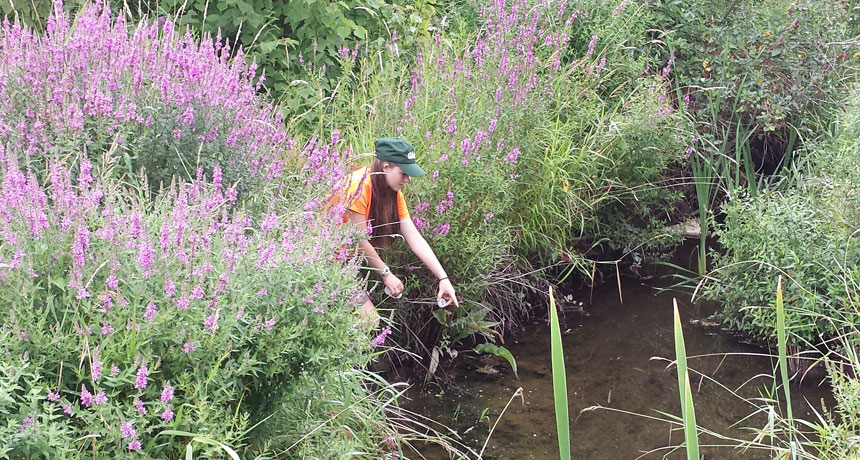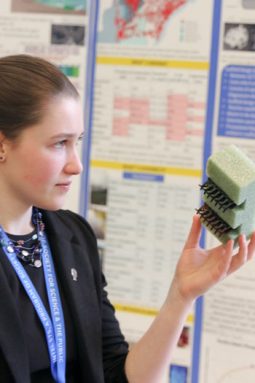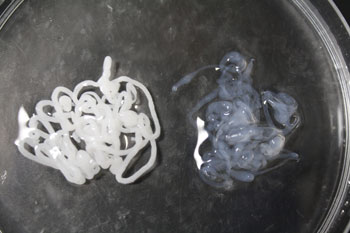This teen designed a filter to save a stream
High school senior studied water pollution in local creeks

Paige Brown checks the water quality in a stream in Bangor, Maine. The teen designed a filter to take excess phosphorus out of the water.
P. Brown
WASHINGTON, D.C. — As a kid, Paige Brown, 17, spent time playing in and around the local streams of Bangor, Maine. She thought they must be pretty clean. After all, she played in them and didn’t get sick. But an experiment in science class at Bangor High School showed that the water might not be as pristine as she had thought. That led Paige to study the streams — and design a filter to remove a serious pollutant that is in them.
The project impressed a number of people. The teen’s work earned her a first place prize of $150,000 here on March 15 at the Intel Science Talent Search. Created by Society for Science & the Public (which publishes this blog) and sponsored by Intel Corp., the competition brings together 40 high school seniors each year. They share their projects with the public and compete for awards. (This year, the total exceeded $1 million.)

This element is an important plant nutrient. When soils do not contain enough of it for crops to thrive, farmers and gardeners may add it as a form of fertilizer. Not all of the fertilizer ends up in the plants, however. Some washes off of the soil during rains. Then it can flow into nearby streams, giving algae and aquatic plants a sudden nutrient buffet. The aquatic greenery will respond by growing explosively.
Later, though, those greens will die. And their decaying remains will fuel the growth of bacteria. As they chow down, those bacteria will use up much of the oxygen in the water. Without that oxygen, fish and other creatures can suffocate. This whole process — from loads of nutrients to water empty of oxygen — is called eutrophication.
The high levels of phosphorus in Paige’s local stream worried her. She wondered what else might be lurking in the nearby waters. To find out, she began working with researchers at the University of Maine in Orono. Their Storm water Management Research Team helps local students get involved in studying water quality.
Paige monitored seven local streams in Bangor over a period of nine months. She measured phosphorus, the stream’s pH — or acidity — and how much oxygen was dissolved in their waters. She also collected bacteria from these streams and then grew colonies of them in her high school lab.
The teen found that phosphorus levels rendered five of her streams “impaired,” according to standards set by the Maine Environmental Protection Agency. This meant their phosphorus levels were too high — putting them at risk of eutrophication.
All seven of the streams Paige studied also had high levels of the bacteria E. coli. When she counted the bacteria, the level in one stream “was off the charts.” she says. High levels of this germ can indicate that the water is dangerous to swim or play in.
Phosphorus and E. coli levels both spiked after rains, Paige found. Streams that were surrounded by buildings and parking lots were affected most. These are places where rain runs directly into the water instead of through a filter of vegetation.

“They’re tiny but mighty,” Paige says of her filters. “Each absorbs 127 milligrams [0.0044 ounce] of phosphorus.” The teen made a housing for her filters out of a foam block and two hair clips. She wrapped the package with a bit of t-shirt to keep hungry fish at bay. The whole apparatus costs around $3.
Paige eventually plans to place the filters in detention ponds. These are holding ponds constructed to collect storm water so that it doesn’t flood the surrounding area. After rains, runoff can sit for a short time before being carefully released into a natural stream or lake. By adding her filters to these ponds, Paige hopes to catch the phosphorus before it can pollute local streams.
And the teen isn’t done. Now that she’s got a filter that removes phosphorus, Paige wants to improve it by adding silver nanoparticles. Such tiny silver bits can kill bacteria, such as those E. coli. By reducing the extra nutrients and bacteria in local streams, Paige hopes to end up with water that is as clean as it looks.
Follow Eureka! Lab on Twitter
Power Words
(for more about Power Words, click here)
algae Single-celled organisms, once considered plants (they aren’t). As aquatic organisms, they grow in water. Like green plants, they depend on sunlight to make their food.
alginate A molecule found normally in brown seaweed. It forms a thick gel that can be used to wound healing and to help build new tissues.
aluminum A metallic element, the third most abundant in Earth’s crust. It is light and soft, and used in many items from bicycles to spacecraft.
bacterium (plural bacteria) A single-celled organism. These dwell nearly everywhere on Earth, from the bottom of the sea to inside animals.
calcium A chemical element which is common in minerals of the Earth’s crust and in sea salt. It is also found in bone mineral and teeth, and can play a role in the movement of certain substances into and out of cells.
detention pond A temporary pond that fills with rainwater, until the water has time to drain away to another place such as a stream.
dissolve To turn a solid into a liquid and disperse it into that starting liquid. For instance, sugar or salt crystals (solids) will dissolve into water. Now the crystals are gone and the solution is a fully dispersed mix of the liquid form of the sugar or salt in water.
E. coli (short for Escherichia coli) A bacterium that researchers often use to study genetics. Some types of this microbe cause disease, but many other forms of it do not.
element (in chemistry) Each of more than one hundred substances for which the smallest unit of each is a single atom. Examples include hydrogen, oxygen, carbon, lithium and uranium.
eutrophication The process by which a body of water becomes full of nutrients, which then stimulates the excessive growth of plants and algae. When these organisms die, bacteria break them down. But this bacterial activity can temporarily use up much of the water’s dissolved oxygen. Without too little oxygen, animals can suffer — even suffocate. In short order, a eutrophic ecosystem can collapse.
fertilizer Nitrogen, phosphorus and other plant nutrients added to soil, water or foliage to boost crop growth or to replenish nutrients that removed earlier by plant roots or leaves.
Intel Science Talent Search An annual competition created and run by Society for Science & the Public and sponsored by Intel Corp. Begun in 1950, this event brings 40 research-oriented high school seniors to Washington, D.C. to showcase their research to the public and to compete for awards.
magnesium A metallic element that is number 12 on the periodic table. It burns with a white light and is the eighth most abundant element in the Earth’s crust.
molecule An electrically neutral group of atoms that represents the smallest possible amount of a chemical compound. Molecules can be made of single types of atoms or of different types. For example, the oxygen in the air is made of two oxygen atoms (O2), but water is made of two hydrogen atoms and one oxygen atom (H2O).
nano A prefix indicating a billionth. In the metric system of measurements, it’s often used as an abbreviation to refer to objects that are a billionth of a meter long or in diameter.
nanoparticle A small particle with dimensions measured in billionths of a meter.
nutrient A vitamin, mineral, fat, carbohydrate or protein that a plant, animal or other organism requires as part of its food in order to survive.
oxygen A gas that makes up about 21 percent of the atmosphere. All animals and many microorganisms need oxygen to fuel their metabolism.
pH A measure of a solution’s acidity. A pH of 7 is perfectly neutral. Acids have a pH lower than 7; the farther from 7, the stronger the acid. Alkaline solutions, called bases, have a pH higher than 7; again, the farther above 7, the stronger the base.
phosphate A chemical containing one atom of phosphorus and four atoms of oxygen. It is a component of bones, hard white tooth enamel, and some minerals such as apatite.
phosphorus A highly reactive, nonmetallic element occurring naturally in phosphates. Its scientific symbol is P. It is an important part of many chemicals and structures that are found in cells, such as membranes, and DNA.
precipitation (in chemistry) The creation of a solid from a solution. This can occur if there is too much of a chemical to dissolve completely in a solution. It also can be a sign that some chemical reaction is taking place. (in meteorology) A term for water falling from the sky. It can be in any form, from rain and sleet to snow or hail.
Society for Science and the Public (or SSP) A nonprofit organization created in 1921 and based in Washington, D.C. Since its founding, SSP has been not only promoting public engagement in scientific research but also the public understanding of science. It created and continues to run three renowned science competitions: The Intel Science Talent Search (begun in 1942), the Intel International Science and Engineering Fair (initially launched in 1950) and Broadcom MASTERS (created in 2010). SSP also publishes award-winning journalism: in Science News (launched in 1922) and Science News for Students (created in 2003). Those magazines also host a series of blogs (including Eureka! Lab).